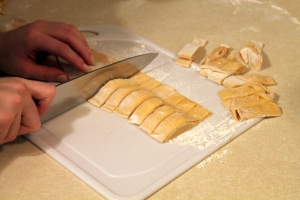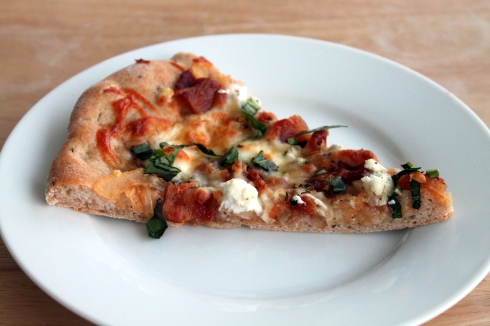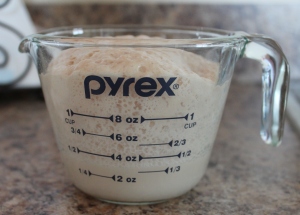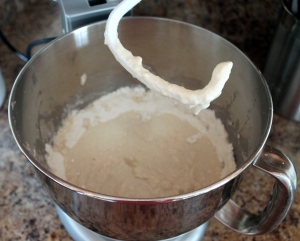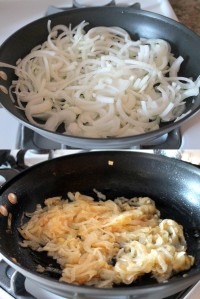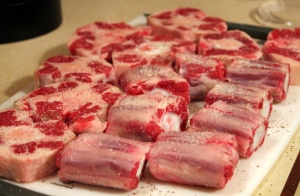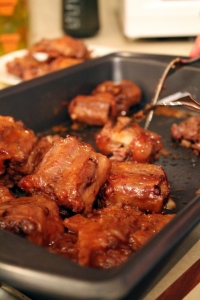One of my New Year’s Resolutions was to try cooking new things, new things I’ve never made before which may intimidate me. Homemade pasta definitely fell into that category.
I’ve made gnocchi before, but never real pasta. I guess I always assumed I needed some fancy pasta maker attachment for my Kitchenaid or something like that. But then I noticed that this recipe for homemade pappardelle requires no fancy equipment and is actually categorized as “easy”. I can do easy.
I would agree that this pasta was pretty easy to make, considering I thought it would be down-right hard. The only frustrating part was when my eggs sort of overflowed over the edges of my flour volcano (see the steps below for explanation!) and so my hands got all sticky trying to save it and knead it. Eventually, after adding more flour, it came together and resembled dough. After which, it was almost therapeutic to knead the dough!
I think half the appeal of homemade pasta is the taste and texture (it really is chewier and better), and half is the satisfaction that comes from knowing you made it out of nothing (flour and eggs count as nothing).
So I encourage you to try making this at home – you may surprise yourself! Soon I will be posting the recipe for the braised oxtail I served atop these beautiful noodles, but until then, enjoy them with copious amounts of butter, parmesan and/or sauce and meatballs.
Homemade Pappardelle recipe from here
Time: 40 active, 40 inactive; Yield: 20 ounces of pasta
- 1 3/4 cups all-purpose flour, plus more for dusting
- 1 cup semolina flour*, plus more for dusting
- 6 large eggs, at room temperature
- 4 teaspoons extra-virgin olive oil
- Pinch of salt
*Semolina flour can either be found in the regular baking/flour aisle or the organic/health food aisle (near all the other alternative flours):
Sift both flours together, pile on a clean counter, and make a well in the center. Make sure the well is very deep so the eggs don’t runneth over in the next step:
Place the eggs, olive oil and a pinch of salt in a bowl, then pour into the well. With a fork, break up the eggs, then gradually mix the wet ingredients into the flour mixture just until combined. This was the very messy step. Try to keep the eggs in the center of the well and very slowly mix in the flour. If it’s too sticky and messy, add some more flour.
Knead by hand, adding more flour if it’s too sticky, until the dough comes together. This was the challenging part – try not to freak out about how messy your hands are, like I did.
Gather the dough into 2 equal-size balls; flour the surface. To knead each piece, push the dough away from you with the heel of your hand, fold the dough over itself and turn it counterclockwise. Continue pushing, folding and turning until the dough is smooth and elastic, 4 to 5 minutes.
Pat each piece into a ball. Flatten slightly, wrap in plastic and refrigerate for at least 30 minutes or overnight. (You can freeze 1 ball for later, or roll out both and freeze the cut pasta).
To roll out the dough, place it on a lightly floured surface and dust with flour. Starting in the middle, push away from you with a rolling pin, easing up on the pressure as you approach the edge. Continue rolling the dough into a sheet, turning occasionally, until you can see your fingers through the bottom. Getting it thin enough is key. Let dry about 10 minutes.
Dust the top of the sheet of dough with flour and loosely roll it into a cylinder.
Using a sharp knife, cut into 3/4-inch-wide slices.
Unwrap the noodles; dust with semolina and gently toss to separate. Place on a sheet pan and cover with a towel until ready to cook (or freeze in freezer bags for up to 2 months).








